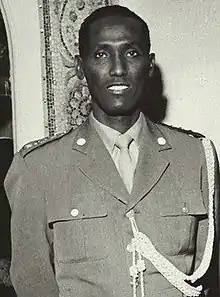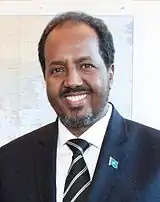Abgaal
The Abgaal (Somali: Abgaal, Arabic: أبغال) is a subclan of the Hawiye and the even larger Samaale clan. It is one of the major sub-clans of the Hawiye and Somali clans in general. The Abgaal have produced many prominent Somali figures including 3 presidents, and the father of the Somali military. It is considered one of the largest sub clans in Somalia. [1][2]
أبغال | |
|---|---|
| Languages | |
| Somali and Arabic | |
| Religion | |
| Islam | |
| Related ethnic groups | |
| Habar Gidir,and other Hawiye and Samaale clans |
Etymology
Italian scholar of Somali and Ethiopian studies Enrico Cerulli studies discusses the origin story of the name Abgaal in his book How a Hawiye tribe used to live.[3]
The mother of Hirabä was Faduma Karanlä. The mother of Abgal was Faduma Sargellä, who was an Aguran. She was espoused by 'Isman Darandollä. By him she had a son, who was called by the name 'Ali 'Isman. Later one went to Sargellä Garën. A learned old man went to him. He said: 'O noble Sargellä, I saw in the books that the children of the boy born to your daughter Faduma will chase your children from the earth. I saw it in the books.' 'Did you see these things?’ 'Yes, I saw them,’ he answered. 'So be it!’ the noble Sargellä replied; and into his heart came the thought: 'Rather than that your children, whom you have begotten, be killed, the son of your daughter might rather die!’ This came into his heart. After this he prepared two different amulets, one good and onebad. The bad one would kill the one who drank it. The good one would protect from any evil of this world. Then he went to his daughter. 'My Faduma, I am bringing you these two amulets: this one here – and it was the good one – you drink; and the other one – and it was the bad one – give to your son 'Ali 'Isman!’ The girl took the two amulets; but when it came to drinking them, she made a mistake! Faduma Sargellä drank the bad one and died immediately. 'Ali 'Ismän drank the good one and survived. Sargellä went back to the hut and saw his daughter dead. And the boy, when he heard his grandfather arrive, ran to the side of a saddle camel and hid behind it. 'Oh 'Ali, oh 'Ali! Come! I am your grandfather!’ Sargellä cried out, looking for the boy. 'You are not my grandfather ( abkäy ), my grandfather is the camels.' The camels ( gel ) in the language of one time were called gal. So afterwards he ('Ali 'Isman) had the name of Ab-gal ('Camel-grandfather').” The tradition substantially recalls the ancient fights between the Abgal, nomadic pastoralists who from places farther north tried to open a way to the river, and the Aguran, who dominated the region of the Middle Webi. This historical content, of course, has been adapted in popular dress with the theme, so widespread in the folklore of quite different peoples, of the prediction of the unborn child destined to drive the reigning prince from the throne. 'In this tradition Abgal has, besides his Somali name, which is explained, also a Mussulman name, 'Ali 'Isman. It does not seem necessary to me to suppose that the name 'Ali replaced the Somali one of Abgal in the genealogies in order to make them more Islamized, as one might say. The custom of several names for one single person, among which names, for the Mussulmans, are found an Arab one and one (or more) in the local language, is common in East Africa, even now.
—Enrico Cerulli, How a Hawiye Tribe use to Live
Overview
The Abgaal are part of the Mudulood and the even larger Hiraab clan.[4] Hiraab consists of the Mudulood, Habar Gidir, Sheekhaal and Duduble.[4] Besides the Abgaal, Mudulood includes Wacdaan, Moobleen, Hiilibi and Udeejeen. The Imam of both Mudulood and Hiraab traditionally hails from the Abgaal. Currently Imam Mohamed Yusuf is the Imam of Mudulood and also carries the dual position of the Imam of Hiraab.[4][5][6][7][8][9][10][11]
Distribution
The Abgaal primarily live in the Mudug, Galguduud, Hiran, Banadir, Middle Shabelle, and Lower Shabelle, regions of Central and Southern Somalia. Moreover, they can be found in some parts of Jubaland. The clan also lives in the Somali region in Ethiopia.[12] They can also be found in the expatriate communities of the Somali diaspora.
Role and influence in Somalia

The Abgaal have historically played an important role in Somali affairs. They are the Somali sub-clan that has produced the most Somali Presidents. These three politicians are Ali Mahdi Muhammad, Sharif Sheikh Ahmed, and Hassan Sheikh Mohamoud.[1][2] These officials constitute three of the four living former Presidents of Somalia. Additionally they are the first and only Somali sub-clan to have had consecutive presidencies in the terms of Sharif Sheikh Ahmed and Hassan Sheikh Mohamed. The father of the Somali military Daud Abdulle Hirsi was also Abgaal. Moreover, the clan has prominent members within the Somali business and media communities. For instance Abdirahman Yabarow, the editor-in-chief of VOA Somali hails from this clan.[13] Currently the Abgaal play a large role primarily in the Somali regions of Galmudug, Hirshabelle, South West State and Banadir (Mogadishu) but also Somalia as a whole.
Poetry
The Abgaal have their own form of Somali poetry. The guurow and shirib are unique poetical genres that are performed by the Abgaal and sometimes neighboring clans. Their poetry has distinctive dialect characteristics. For instance "iyo" with a long 'o' is a feature within their poetry. The most popular of Abgaal poetry is the shirib. The shirib are short songs that usually accompany dancing. They are sung during various gatherings such as family meetings, clan meetings, and celebrations.[14]
Clan tree
Ali Jimale Ahmed outlines the Abgal clan genealogical tree in The Invention of Somalia:[15]
- Samaale
- Irir
- Hawiye
- Gorgaarte
- Hiraab
- Mudulood
- Darandoolle
- Abgaal
- Harti
- Agoonyar
- Owbakar
- Habar Nugaal
- Cabdalla Caroone
- Yabar Mohamed
- Ciise Harti
- Wacbuudhan
- Daa'uud
- Kabaale
- Reer Mataan
- Maxamed Muuse
- Celi Cumar
- Waceysle
- Haaruun
- Faqay
- Cabdiraxmaan
- Absuge
- Macalin Dhiblaawe
- Cali Gaaf
- Harti
- Abgaal
- Darandoolle
- Mudulood
- Hiraab
- Gorgaarte
- Hawiye
- Irir
Prominent members
- Sharif Sheikh Ahmed, Former President of Somalia
- Hassan Sheikh Mohamud, Former President of Somalia
- Diva, Prospective minyaro of Hassan Sheikh Mohamud
- Nur Hassan Husein, Former Prime Minister of the Transitional Federal Government
- Ali Ghedi, Former Prime Minister of the Transitional Federal Government
- Ali Mahdi Muhammad, President of Somalia from 1991– 1997
- Hussein Kulmiye Afrah, Vice-President of Somalia under the Siad Barre Regime
- Ahmed Maxamed Xasan, Lieutenant Colonel in the Somali Airforce who defused the MiG-17 jet fighter bombs[16]
- Salaad Gabeyre Kediye, Major General in the Somali Military, and chairman of the Somali Revolution Waceysle
- Ismail Jim'ale Osoble, Somali lawyer and Minister of Information in the government of Aden Abdulle Osman
- General Daud Abdulle Hirsi, First Commander-In-Chief of the Somali National Army Forces Waceysle
- Salad Ali Jelle, Deputy Minister of Defense of the Transitional Federal Government- Agoonyar
- Ali Jimale, Educator at the City University of New York
- Mohamud Siad Togane, Somali-Canadian poet, professor, and political activist
- Adde Gabow (Mohamed Ali Hassan), Politician, Governor and Mayor of Mogadishu
- Abukar Umar Adani, Islamist, businessman who used to control the El-ma`an beach area which served as Mogadishu's port since the closure in 1995 of the city's main port[17]
- Bashir Raghe Shiiraar Leader of the Alliance for Peace and the Fight Against International Terrorism.[17] Warsangali
- Ali Dhere, Cleric and the Head of the first Islamic Court in northern Mogadishu [18]
- Farah Weheliye Addow (Sindiko), Former Vice President of the Confederation of African Football[19][20]
- Abdulahi Afrah, Minister of Commerce[21][22]
- Abdi Mohamed Ulusso, PhD Holder, Intellectual and 2004 Somali Presidential Candidate [23]
- Hussein Bood, Politician and Ex-Minister of National Planning, 1977–1981[24][25]
- Hilowle Omar, Chairman of the (Somali Reconciliation and Reconstruction Council) (SRRC)[23][26][27]
- Mohamed Ameriko, Somali Ambassador to Kenya[28]
- Ayub Daud, Professional Footballer
- Hussein Sheikh Ahmed Kaddare, Orthographer and the Inventor of the Kaddariya Script[29][30]
- Abdirahman Yabarow, Editor-in-Chief of the VOA Somali Service
- Omar Mohamed, Professional Footballer
References
- Metz, Helen Chapin (1993). Somalia: a country study. The Division. p. 155. ISBN 978-0844407753. Retrieved 10 June 2014.
- "Somalia Federal Parliament elects Hassan Sheikh Mohamud as President". Garowe Online. 10 September 2012. Retrieved 10 September 2012.
- Enrico, Cerulli, How a Hawiye Tribe Used to Live chapter, published in: Somalia, scritti vari editi ed inediti, Vol. 2, edited by Enrico Cerulli, Roma, 1959.
- "Archived copy". Archived from the original on 24 February 2007. Retrieved 31 March 2009.CS1 maint: archived copy as title (link)
- Lewis, I. M. (1 January 1998). Peoples of the Horn of Africa: Somali, Afar and Saho. Red Sea Press. p. 25. ISBN 9781569021057.
- Lewis, I. M. (1 January 1998). Peoples of the Horn of Africa: Somali, Afar and Saho. Red Sea Press. ISBN 9781569021057.
At the end of the book "Tribal Distribution of Somali Afar and Saho"
- Verdier, Isabelle (31 May 1997). Ethiopia: the top 100 people. Indigo Publications. p. 13. ISBN 9782905760128.
- Hayward, R. J.; Lewis, I. M. (17 August 2005). Voice and Power. Routledge. p. 242. ISBN 9781135751753.
- The Quranyo section of the Garre claim descent from Dirr, who are born of the Irrir Samal. UNDP Paper in Keyna http://www.undp.org/content/dam/kenya/docs/Amani%20Papers/AP_Volume1_n2_May2010.pdf
- Adam, Hussein Mohamed; Ford, Richard (1 January 1997). Mending rips in the sky: options for Somali communities in the 21st century. Red Sea Press. p. 127. ISBN 9781569020739.
- Ahmed, Ali Jimale (1 January 1995). The Invention of Somalia. The Red Sea Press. p. 121. ISBN 9780932415998.
- "Cabdiraxmaan Yabarow oo ugu hanjabay inuu Shaqada VOAda ka ceerini doono Cabdullahi Kolombo". IjaraNews. 21 December 2013. Archived from the original on 11 August 2014. Retrieved 7 August 2014.
- Giorgio Banti and Francesco Giannattasio (1996). "Music and Metre in Somali Poetry". African Languages and Cultures. Supplement (3): 83–127. JSTOR 586655.
- Ali Jimale Ahmed (1995). The Invention of Somalia. Lawrenceville, NJ: Red Sea. p. 123. ISBN 978-0-932415-98-1.
- "Archived copy". Archived from the original on 1 July 2008. Retrieved 1 July 2008.CS1 maint: archived copy as title (link)
- John Pike (22 March 2006). "SOMALIA: Twelve killed in heavy fighting in Mogadishu". Globalsecurity.org. Retrieved 27 February 2013.
- A. Duale Sii'arag (15 November 2005). "The Birth and Rise of Al-Ittihad Al-Islami in the Somali Inhabited Regions in the Horn of Africa". Newbanadir.com. Archived from the original on 20 June 2007. Retrieved 27 February 2013.
- "Somalia: Farah Addo elected chairman of football federation". Mareeg.com. Retrieved 27 February 2013.
- "Archived copy". Archived from the original on 22 September 2008. Retrieved 19 August 2008.CS1 maint: archived copy as title (link)
- "CFS". Canadian Friends of Somalia. Archived from the original on 28 September 2008. Retrieved 27 February 2013.
- John Pike (21 August 2006). "SOMALIA: Premier appoints new cabinet". Globalsecurity.org. Retrieved 27 February 2013.
- "Rival Somali gunmen call it quits | News | Mail & Guardian". Mg.co.za. 1 January 2002. Retrieved 27 February 2013.
- "Warlords agree on Mogadishu authority". BBC News. 22 December 1999. Retrieved 23 April 2010.
- "Declaration on Cessation of Hostilities and the Structures and Principles of the Somalia National Reconciliation Process (S/2002/1359) | ReliefWeb". Reliefweb.int. 13 December 2002. Retrieved 27 February 2013.
- "PROFILE: Dr. Mohamed Ali "Ameriko"". Banadir.com. Retrieved 27 February 2013.
- Laitin, David D. (1977). Politics, Language, and Thought: The Somali Experience. University of Chicago Press. p. 87. ISBN 978-0-226-46791-7.
- Biber, Douglas; Finegan, Edward (1993). Sociolinguistic Perspectives on Register. Oxford University Press, USA. p. 213. ISBN 978-0-19-535932-9.
